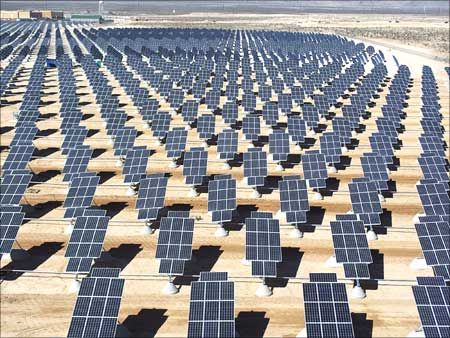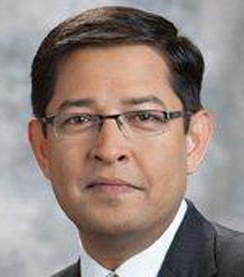
US-based solar energy panel maker First Solar was the first global entrant in the Indian market since the inception of the National Solar Mission in 2011.
Sujoy Ghosh, chief executive officer, bottom, left, First Solar India, tells Shreya Jai the momentum for investment is high in the country and states need to act now.
Excerpts:
How has the investment environment changed for the solar energy sector in India in the past five years?
The new government, when it came to power, scaled up renewable energy targets, and ever since, there have been enabling regulations.
One was for demand creation and the other was to improve the quality of the off-take of power through power purchase agreements, which is not very bankable, given the financial status of the discoms.
The challenges, however, are to provide infrastructure for these targets, bring in capital and mitigate risks around land issues.
For that, the central government has done its part by bringing in National Thermal Power Corporation and Solar Energy Corporation of India to be the procurers.
The solar park policy created a mechanism to give funds to those states which wanted to buy land and create infrastructure for the mega solar parks.
The solar parks that have come for auction till now have been over-subscribed in terms of capacity and fairly significant equity investment.
Which gaps do you think need to be filled?
The Renewable Purchase Obligation would worry anyone.
Though the Centre has put penal provisions, the states have not enforced it. Procurement would come with falling tariff and closing of the demand-supply gap.
States have to implement the central regulations.
Also, the cost of capital remains high in India.
Local debt rates are 11-11.25 per cent, whereas in matured markets, infrastructure projects avail long-term debt at two-three per cent.
In First Solar’s global plan, how is India placed?
Outside the US and China, India is the fastest growing market.
In terms of growth rate, India is better than China, which is growing but is finding it difficult to get foreign capital.
Our results in this market and the ability to command a leadership position would enable us to continue investment in India.
In terms of market share, we had 16.5-17 per cent by the end of 2015, making us the leader in India. In that mix, our own development was five per cent and 95 per cent of our capacity are modules sold to others.
Nearly 900 Mw in the total installed capacity of 5,000 Mw, is supplied by us. Our technology has also improved — energy generation efficiency has improved to 16.7 per cent from 11 per cent in 2011.
How has the Indian solar market matured in terms of players?
There are two kinds of players in the Indian market. Developers like us, SunEdison, Azure Power, essentially breaking the initial risk capital to create an asset. Once they create an asset, the companies would like to turn these to long-term assets, recycle their money and keep bidding for more assets.
Their value lies in risk mitigation of initial development constrictions and finance.
The other class of players are long-term asset owners -- ideally, a utility which is willing to invest a lot of money at a predictable but low rate of return.
But, as the government is mitigating a lot of risk, we are witnessing long-term asset owners coming and building the projects. Many foreign utilities are coming in to take up capacity addition.
This will lower cost of energy and create more demand.
 Panel prices have been going down for over a year now. What are its impact on the Indian market and your operations?
Panel prices have been going down for over a year now. What are its impact on the Indian market and your operations?
Since 2014, we have seen a decline of five per cent in panel prices. Currently, the average market price of a panel is nearly 46 cents a unit.
In 2012 it was more than $1 a unit.
Most of this decline happened because of excess capacity in China where we are seeing consolidation and bankruptcies in major Chinese firms.
All the Chinese players are our competitors in India.
In terms of competition, most Indian companies are targeting the domestic content requirement segment, where the Indian government has reserved a certain capacity.
We don’t play in this segment.
Both, we and the Chinese players are at par in prices, considering the level of quality and efficiency. On levellised costs of energy basis, we are better than the Chinese.
I don’t know what Indian panel costs are since we do not follow the segment. But, if you follow tariffs under DCR, the bids are slightly higher.
DCR is still being contested in World Trade Organization. Your comment?
In 2012, the government said they will reserve capacity for domestic firms but they excluded thin-films so we were not affected by that.
The percentage of the National Solar Mission against the country’s total solar program was relatively small at 150 Mw and 350 Mw.
But, states such as Gujarat and Madhya Pradesh did more and that’s when the WTO dispute happened. Subsequently, the government changed its stand.
The restrictions are where the government is buying power and owning the assets. So, this is different from the DCR in 2012.
I am not privy to discussions in WTO.
As a policy, our stand is that we oppose any kind of market restrictions.
We want the market to be accessible to all technologies. We as a company would continue to advocate against any kind of restrictive market access.
Having said that, we think the Indian market is lot more open than any other solar market globally.











 © 2025
© 2025